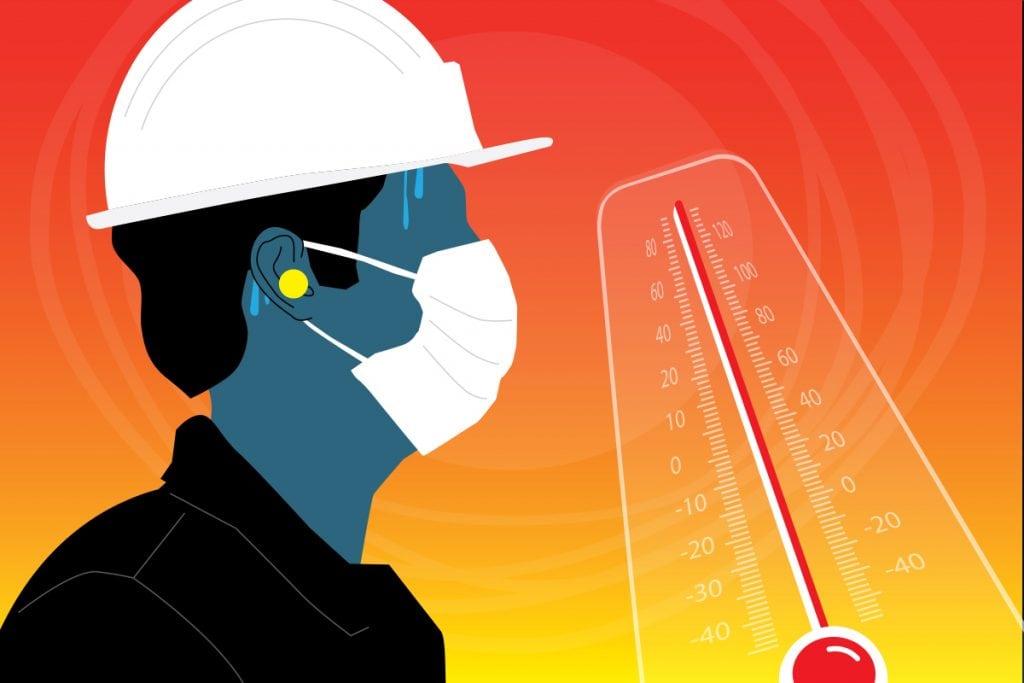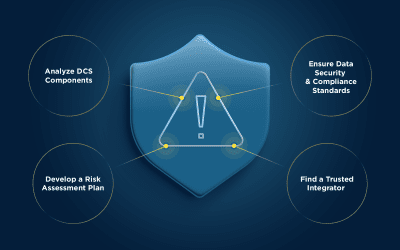Beat the Heat
Prevent heat-related illnesses with these safety tips
The dog days of summer are here, and with it comes uncomfortable heat and humidity. For some people, it can be downright dangerous. Excessive heat, high levels of humidity, sweating and decreased water intake can lead to dehydration. Dehydration occurs when the body’s output of water is greater than the body’s intake.
Heat-related illnesses should be viewed as a serious health problem—one that can even be fatal. Staying hydrated and cool is key to preventing heat-related illnesses whether you’re at work or at home.
Real-World Heat Risks
All individuals are at risk when working outdoors on a hot summer day or when they are exposed to extreme heat environments where personal protective equipment (PPE) – and now face masks – are required. They are also at risk when working in poorly ventilated areas or where air conditioning is limited, such as work performed on scaffolding where the air temperature rises with altitude.
According to the Occupational Health and Safety Administration (OSHA), thousands of outdoor workers experience heat illness each year, and most outdoor fatalities (50% to 70%) occur in the first few days of working in hot environments due to heat intolerance or lack of acclimatization.
OSHA law requires companies to ensure workplaces are free of known safety hazards, including protecting personnel from extreme heat conditions. Companies must provide workers with water, rest and shade; allow workers to take more frequent breaks to build up heat tolerance (which can take up to 14 days); provide heat stress training to workers and supervisors; plan for emergency situations; and monitor workers for signs of illness.
On the home front, children are at risk when playing sports, swimming at the local pool or doing other outdoor activities in extreme heat. Without proper fluid intake, they can quickly feel lethargic, thirsty, disoriented, nauseous, dizzy, faint or develop fever-like symptoms, including chills. These same heat-stress warning signs can occur in adults when, for example, working in the yard or exercising outdoors. Fluid intake is extremely important for those adults most prone to heat illnesses, such as the elderly or those with underlying medical conditions (e.g., high blood pressure).
Much depends on the situation. Anyone exposed to high temperature and humidity levels for a prolonged period of physical exertion can be susceptible to various heat disorders, such as heat cramps, heat exhaustion or the most dangerous, heatstroke.
All heat disorders can quickly progress to hyperthermia or overheating of the body’s core temperature to dangerous levels. The hotter it gets, the more stress on the body. Heat stress can quickly lead to heat exhaustion and then to heatstroke if early warning signs are ignored.
Heat Disorders, Symptoms and Prevention
Heat Cramps
Overexertion and heavy sweating result in heat cramps, which are severe muscle spasms that often start suddenly in the hands, calves or feet. Heat cramps are painful and disabling. In this condition, your muscles become hard, tense and difficult to relax. This is caused from salt depletion. To ease these symptoms, drink water at regular intervals (e.g., 15 minutes or so apart) or an electrolyte-rich sports drink (e.g., Gatorade) and move to a cool shady area.
Heat Exhaustion
This condition results from prolonged exposure to extreme heat for many hours. Symptoms include heavy sweating, extreme weakness or fatigue, blurred vision, dizziness, confusion, nausea, pale or flushed complexion, muscle cramps, slightly elevated body temperature, fast and shallow breathing, high pulse rate and unstable walking. If a person is showing warning signs, follow these steps:
- Move them to a shady area or cool environment
- Lay person down with legs straight and elevate feet 8 to 12 inches
- Loosen or remove any excess clothing
- Apply cold packs or wet towels or cloths to forehead and neck
- Don’t leave them alone
- Have them drink cold water if conscious
- Don’t let them get too chilled
- Call Emergency Medical Services (EMS) if no improvement is noted within 20 minutes or sooner
Heatstroke – Danger: Medical Emergency
One of the most serious heat-related illnesses is heatstroke – where your body is unable to control its temperature. If your body temperature rises rapidly and your sweating mechanism fails, the body is unable to cool down and vital organs can shut down.
According to the Center for Disease Prevention and Control (CDC), body temperatures can rise to 106°F or higher within 10 to 15 minutes. In this instance, heatstroke can cause death or permanent disability if emergency treatment is not provided. Warning signs may include:
- An extremely high body temperature (above 103°F)
- Red, hot and dry skin (no sweating)
- Rapid, strong pulse
- Throbbing headache
- Dizziness
- Nausea
- Confusion
- May suffer convulsions
- Unconsciousness
When a person is suffering from hyperthermia, it is vitally important to reduce their core body temperature immediately and then control the secondary effects. Contact EMS immediately and get the person in some shade or out of the heat altogether. Place cool damp towels over the head, on the neck, between the thighs and under the armpits.
Tips for Staying Cool and Hydrated
- When possible, avoid operations with very hot environments or poorly ventilated workspaces during peak heat hours of the day
- Pace yourself. Take more frequent breaks to gradually build up a tolerance for working in the heat
- Use clothing such as a head covering, wet bandana around the neck or continuous re-wetting of clothing to prevent hyperthermia
- Continuously replace fluids and salts (electrolytes) lost through heavy sweating
- Drink plenty of fluids (preferably water)
- Be aware of any health conditions or medications affected by heat and sun (always wear sunscreen!)
If exertion in the heat makes your heart pound and leaves you gasping for breath, STOP all activity. Get into a cool area, or at least in the shade – and rest, especially if you become lightheaded, confused, weak or faint. Overall, it is imperative that you drink plenty of fluids and do everything needed to keep your core body temperature within manageable levels.
Hydrate to stay cool and be safe!



